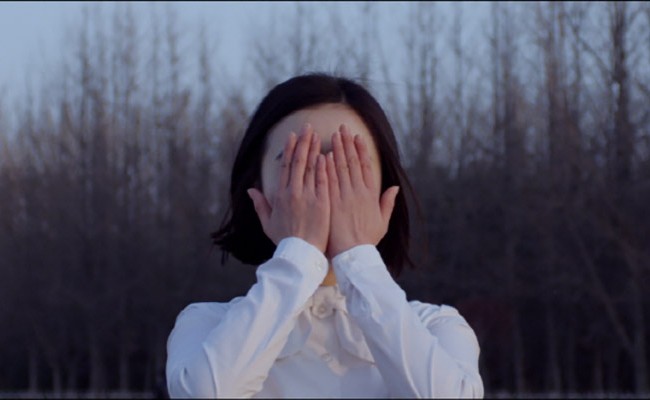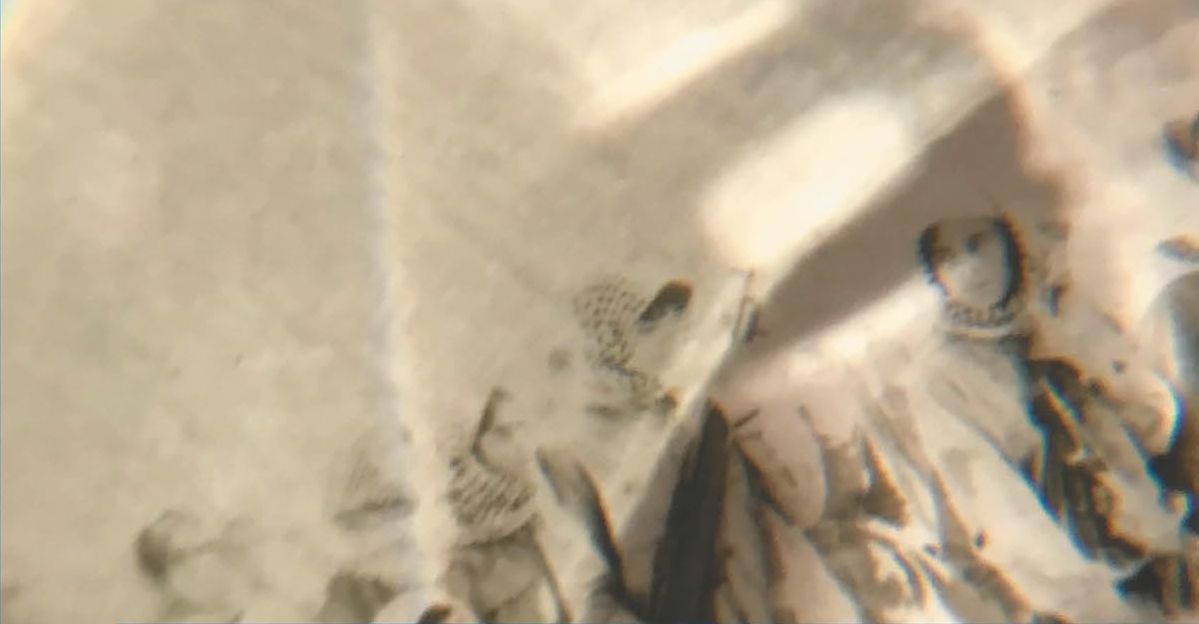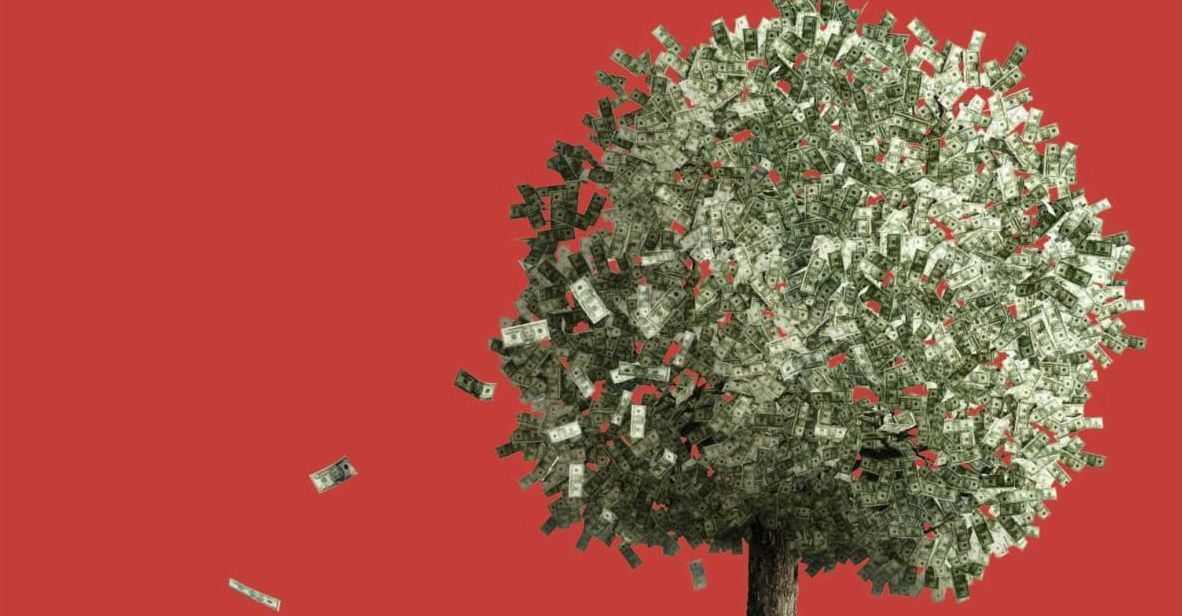A gallery attendant, dressed smartly in black, stands to attention. She wears a vest, hi-vis workwear style, emblazoned with capital letters: THREE GENERATIONS OF ONE FAMILY HAVE LOST THEIR JOBS. A miner lies hunkered down in a narrow passageway, his face blackened with dirt and shadow. The small beam of light from his helmet punctuates the solid darkness. Factory workers sit hunched before sewing machines, crammed together in endless rows beneath garish fluorescent lighting. These three kinds of workers come from disparate social and historic contexts, but are united at the Ian Potter Museum in the exhibition State of the Union.
This exhibition focuses on Australian workers rights and trade union movements from the twentieth century through to the present day (with a few international interventions). Union banners and archival material is presented seamlessly alongside artworks from the social realism movement of the twentieth century and from the contemporary era. A key component of the exhibition is also dedicated to the labour of art, foregrounding collaborations between artists and trade unions and the labour of being an arts worker.
However, the strength of State of the Union lies in its multifaceted representation of the labour movement with consideration to gender, immigration and globalisation. In the current post-Brexit post-Trump climate, where these issues are often polarised against the white working class, this exhibition highlights instances where they’ve aligned. Obvious curatorial selections that speak to Australia’s myth of the working-class battler like Ambrose Dyson’s Eureka/unity and banners from the recent Change the Rules rally in Melbourne are displayed alongside works that show varied perspectives and unlikely instances of solidarity.
Alex Martinis Roe’s It was about opening the very notion that there was a particular perspective (2015–17) is a standout example. The subject of this video installation is a student strike at the University of Sydney in the 1970s in support of funding for a feminist philosophy course. This strike was supported by the New South Wales Builders Labourers Federation (BLF) who threatened a campus-wide ban on construction. While this unexpected alliance is celebrated in Martinis Roe’s video, it’s also complicated through the inclusion of interviews with Pat Fiske — the first woman to be accepted as a builder’s labourer in Sydney. Martinis Roe’s work is a nuanced view of the intersection of feminism and the trade union movement. (Aptly, it was also recently exhibited in Unfinished Business, a feminist exhibition at the Australian Centre for Contemporary Art).
It was about opening the very notion that there was a particular perspective (2015–2017), Alex Martinis Roe, video still
Martinis Roe’s emphasis on feminist-trade union camaraderie is complemented by activist posters that speak to the importance of feminism and anti-racism in the fight for workers’ rights. Some of these posters do ring a bit hollow, with platitudes like ‘Racism divides the working class’ and ‘Racism is union business’. But the ample space given to exploring this archival history is a testament to the exhibition’s commitment to highlighting the intersection of identity and class politics.
Tully Moore’s mural Greater Together (2018) and video Chasing Shadows (2018) also offers a less common narrative of the Australian working-class labourer. Centred around the Electrolux fridge factory in Orange NSW, Moore reflects upon how the factory was a hub of the community for newly arrived European immigrants who changed the Anglo-Irish face of Australia — a reminder of the history, struggles and communities of working-class immigrants.
These themes are continued in Im Heung-Soon’s documentary-style video Factory Complex (2015), where feminised labour is placed in the current global context. Factory Complex examines the working conditions of Korean women across various low-paid, insecure and exploitative work through interviews with supermarket checkout workers, flight attendants and call centre employees. The video then turns to workers in Korean owned garment factories in Cambodia and a bloody protest where five people were killed when workers clashed with police. Heung-Soon’s video moves us to think about how labour and class functions on a global scale.
The harrowing nature of Factory Complex contrasts against the triumphant and celebratory visions of the labour movement evoked elsewhere in the exhibition. In another review of State of the Union, Mem Capp comments that Factory Complex presents ‘a good comparison to work place safeguards that were taken for granted in Australia thanks to the legacy of our labour movement’. But restricting Heung-Soon’s work to a nationalist perspective is limiting, as Factory Complex clearly speaks to the global scale of worker exploitation. In one part of the video, the Cambodian workers in the Korean-owned factories list the countries the clothing they make is shipped to, and there’s footage of protests in Korea calling for foreign workers to be awarded the same rights as Koreans. This glimpse of the trans-national campaign for workers rights is a reminder that the fight needs to be fought on a global scale – particularly timely in our current political climate when protectionism and nationalism tinged with racism is often evoked as the answer to neoliberal globalisation.
Visions such as these, of immigrant workers and Cambodian women in sweatshops, stand in stark contrast to previous, commonly glorified visions of labour — of hyper-masculine, nationalistic representations such as the miners in Jeremy Deller’s The battle of Orgreave (2001), and Noel Counihan’s gristly sketches and bold lino-prints of the harsh working conditions miners and factory labourers. State of the Union speaks to the need to shift the narrative of workers rights movements. But this turn towards the experiences of women, immigrants and workers across the globe doesn’t feel like a challenge; it feels like a firm nod of solidarity.
State of the Union runs until 28 October at the Ian Potter Museum of Art, University of Melbourne
Lead image: still from Factory Complex, Im Heung-Soon.





